
Ypsolophidae is a family of moths with some 160 species. They are included in the Plutellidae by many authors.
Canariella leprosa is a species of small air-breathing land snails, terrestrial pulmonate gastropod molluscs in the family Canariellidae, the hairy snails and their allies. This species is endemic to Tenerife, Canary Islands.
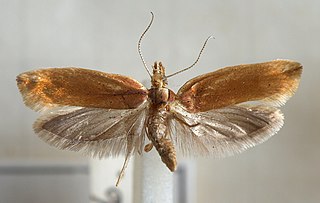
Ypsolopha ustella, the variable ypsolopha moth, is a moth of the family Ypsolophidae. It is found in most of Europe and is also present in North America.
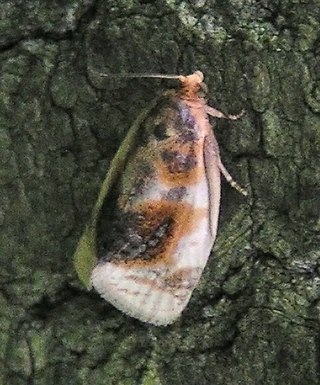
Clepsis melaleucana, the black-patched clepsis, is a moth of the family Tortricidae. The species was first described by Francis Walker in 1863. It is found in North America from Alberta to Newfoundland, south to North Carolina and Missouri.

Ctenucha virginica, the Virginia ctenucha, is a moth of the family Erebidae. The species was first described by Eugenius Johann Christoph Esper in 1794.
Hypocoena basistriga is a species of moth of the family Noctuidae first described by James Halliday McDunnough in 1933. It is found from Newfoundland and Labrador west to British Columbia and Yukon. This species of moth is found to frequent mesic areas including the edges of aspen bluffs and hayfields, old fields, meadows, etc.
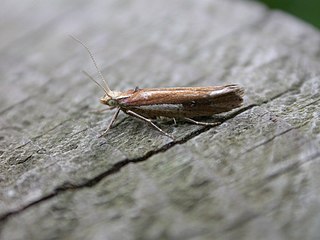
Ypsolopha parenthesella is a moth of the family Ypsolophidae. It is found from Europe to Japan, as well as north-eastern China, Asia Minor and mideast Asia.
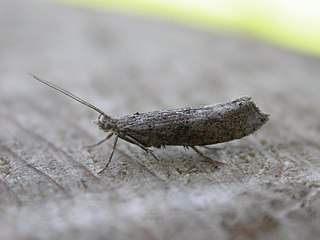
Ypsolopha horridella is a moth of the family Ypsolophidae. It is found in northern and central Europe, the Middle East, China and Russia.
Ypsolopha dorsimaculella is a moth of the family Ypsolophidae first described by William D. Kearfott in 1907. It is found throughout North America. In Canada, it is known from British Columbia, Alberta and Saskatchewan. It is known from most of the continental United States. The habitat consists of mixed wood forests, riparian areas and possibly scrubland.
Ypsolopha dentiferella is a moth of the family Ypsolophidae first described by Lord Walsingham in 1881. It is found throughout North America. In Canada, it occurs in most provinces, being most frequently collected in British Columbia and Alberta. It has been found in a wide variety of habitats, including mixed wood forests, semi-arid scrubland, prairies and badlands.
Ypsolopha senex is a moth of the family Ypsolophidae first described by Lord Walsingham in 1889. It is found throughout North America. In Canada it occurs in most provinces, from British Columbia and Alberta to Manitoba. It is present in most of the continental United States. It is known from a wide variety of habitats, including riparian ecosystems, mixed wood forest and alpine tundra.
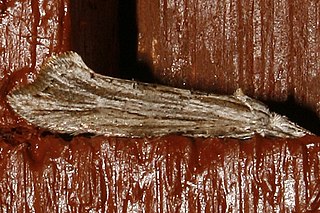
Ypsolopha falciferella is a species of moth in the family Ypsolophidae first described by Lord Walsingham in 1881. It is found throughout much of North America, including British Columbia, Alberta, Manitoba, Saskatchewan, Michigan and Maryland. It is known from a wide variety of habitats, including mixed wood forests, riparian habitats and semi-arid scrubland.
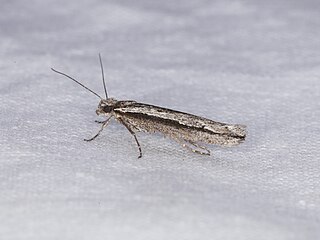
Ypsolopha flavistrigella is a moth of the family Ypsolophidae first described by August Busck in 1906. It was known only from the southern part of the United States, but has also been recorded from Alberta, Canada.
Ypsolopha nella is a moth of the family Ypsolophidae. It is known from the United States, including Arizona and Utah.
Ypsolopha querciella is a moth of the family Ypsolophidae. It is known from the United States, including Arizona and Utah.
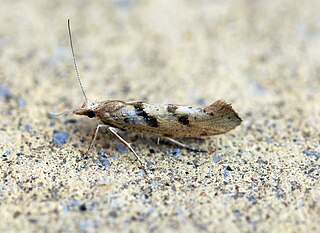
Ypsolopha sylvella is a moth of the family Ypsolophidae. It is found in most of Europe.

Ypsolopha falcella is a moth of the family Ypsolophidae. It is known from northern and central Europe and Russia.

Ypsolopha is a genus of moths of the family Ypsolophidae. It is the type genus of the family and comprises over 120 described species.
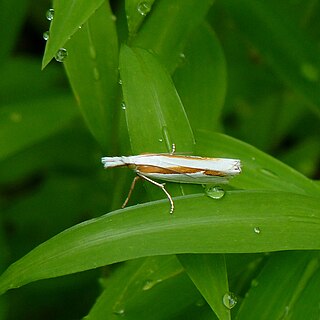
Crambus girardellus, or Girard's grass-veneer moth, is a moth in the family Crambidae described by James Brackenridge Clemens in 1860. It is found in North America, including Alberta, Ontario, Quebec, Labrador, Maine, New Hampshire, Massachusetts, New York, Pennsylvania, Maryland, Ohio and Michigan.

Macaria aemulataria, the common angle moth, is a moth in the family Geometridae. The species was first described by Francis Walker in 1861. It is found from Nova Scotia to Florida, west to Texas, north to Oregon and Alberta.












